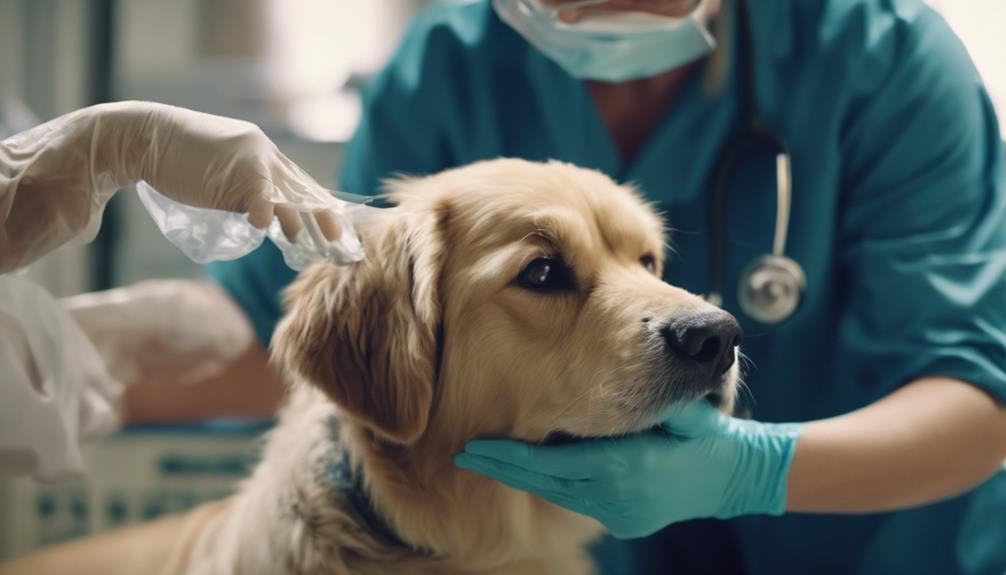Canine influenza is a viral respiratory infection that affects dogs. It has garnered attention in recent years due to its potential impact on canine health. The question of whether dogs can contract the flu is significant, prompting pet owners to consider the implications for their furry companions.
Understanding the nuances of canine influenza transmission and its implications for dog welfare is crucial in navigating the complexities of this infectious disease. By exploring the intricacies of canine flu and its implications for dogs, pet owners can take proactive steps to protect their beloved pets from potential risks.
Key Takeaways
- Canine flu spreads through respiratory secretions and contaminated surfaces.
- Symptoms range from mild cold-like signs to severe pneumonia.
- Vaccination and preventive measures are crucial for controlling outbreaks.
- Close contact with infected dogs in high-risk environments increases transmission risk.
Understanding Canine Influenza Transmission
In comprehending the transmission of canine influenza, it is essential to recognize the distinct pathways through which the virus spreads among dogs. Canine influenza primarily spreads through respiratory secretions, such as coughing and sneezing, from infected dogs. These droplets can land on surfaces, where the virus can remain infectious for up to 48 hours.
Uninfected dogs can then pick up the virus by coming into contact with these contaminated surfaces or by being in close proximity to infected dogs. Additionally, the virus can be transmitted through direct physical contact between dogs, such as sharing water bowls or toys. Understanding these modes of transmission is crucial in implementing effective strategies to prevent the spread of canine influenza among dogs.
The Spread of Dog Flu
The dissemination of dog flu primarily occurs through airborne canine influenza viruses, posing a significant risk to uninfected dogs in close proximity to sick animals. This mode of transmission highlights the importance of understanding how easily the virus can spread among our canine companions. To grasp the full extent of the spread of dog flu, consider the following points:
- Close Contact: Dogs in close contact with infected animals are at higher risk.
- Shared Spaces: Environments where multiple dogs gather, such as kennels or dog parks, can facilitate the spread.
- Virus Survival: Canine flu viruses can survive on surfaces for a certain period, increasing the chances of transmission.
Symptoms and Severity in Dogs

Symptoms of canine influenza in dogs manifest in varying degrees of severity, indicating the potential seriousness of the viral infection. Mild cases may resemble a common cold or kennel cough, with symptoms such as a cough, runny nose, and low-grade fever.
In more severe instances, dogs can exhibit persistent coughing, sneezing, high fever, nasal discharge, and lethargy. Some affected dogs may also experience difficulty breathing, loss of appetite, and dehydration.
In severe cases, canine influenza can progress to pneumonia, which can be life-threatening if not promptly addressed by a veterinarian. Therefore, it is crucial for dog owners to monitor their pets for any signs of flu-like symptoms and seek veterinary care if needed.
Treatment Options for Canine Influenza
Having understood the potential severity of canine influenza symptoms in dogs, it is essential to explore the available treatment options for addressing this viral infection. When a dog is diagnosed with canine influenza, treatment options may include:
- Supportive Care: Providing supportive care to manage symptoms such as rest, hydration, and nutrition.
- Medications: Veterinarians may prescribe medications to alleviate coughing, reduce fever, or treat secondary bacterial infections.
- Isolation and Monitoring: Isolating the infected dog to prevent the spread of the virus to other pets and monitoring their condition closely for any worsening symptoms.
These treatment measures aim to help the dog recover from canine influenza and prevent complications that may arise from the infection.
Preventing Canine Influenza Outbreaks

To mitigate the risk of widespread canine influenza outbreaks, proactive vaccination strategies and diligent hygiene practices are paramount in safeguarding the health of dogs in various environments.
Vaccination against canine influenza is a crucial step in preventing the spread of the virus, especially in high-risk settings such as training facilities, dog competitions, and boarding kennels. By ensuring that at-risk dogs are up to date on their vaccinations, pet owners and caretakers can help create a barrier against the transmission of the virus.
Additionally, practicing good hygiene, such as regular handwashing, cleaning and disinfecting shared spaces, and isolating sick dogs, can further reduce the likelihood of outbreaks. These preventive measures play a vital role in protecting the canine population from the potentially severe consequences of influenza.
Differentiating Mild and Severe Cases
In understanding the impact of canine influenza on dogs, recognizing the distinction between mild and severe cases becomes vital for timely intervention and appropriate care.
- Mild cases of canine influenza can mimic symptoms of a cold or kennel cough, often including a mild cough and runny nose.
- Severe cases of dog flu present with more pronounced symptoms such as persistent coughing, sneezing, high fever, difficulty breathing, and lethargy.
- Dogs with severe cases of canine influenza are at risk of developing pneumonia, which can be life-threatening if not promptly addressed by a veterinarian.
Understanding these differences can help pet owners identify when their dog may need urgent medical attention and ensure the best possible outcome in managing the illness.
Managing Contagious Dogs at Home

The containment of contagious dogs within a household setting requires strict adherence to isolation protocols and vigilant monitoring of symptoms. Infected dogs should be separated from other pets to prevent the spread of the virus. Designate a specific area for the sick dog with separate food and water bowls, bedding, and toys. Limit contact with the infected dog and ensure that all interactions are kept to a minimum.
Wash hands thoroughly after handling the sick dog or any of their belongings. Disinfect common areas and surfaces regularly to eliminate any virus particles. Monitor the infected dog's symptoms closely and seek veterinary care if their condition worsens. By implementing these measures, the risk of spreading canine influenza within the household can be significantly reduced.
Addressing Breathing Difficulties in Dogs
Addressing breathing difficulties in dogs, especially in cases of canine influenza, requires immediate attention and careful monitoring to ensure the well-being of the affected pet.
Tips for Addressing Breathing Difficulties in Dogs:
- Observe Respiratory Rate: Watch for rapid or labored breathing, which can indicate respiratory distress.
- Keep Calm: Dogs can pick up on their owners' stress, potentially worsening their breathing difficulties.
- Isolate from Other Pets: Prevent the spread of any contagious respiratory illnesses and ensure the affected dog gets proper rest.
Identifying Early Signs of Dog Flu

Early detection of canine influenza is essential in providing timely care and management for affected dogs. The initial signs of dog flu may include coughing, sneezing, nasal discharge, and fever. These symptoms can be mild at first, often resembling a common cold or kennel cough.
However, as the illness progresses, dogs may experience more severe symptoms such as difficulty breathing, lethargy, and a persistent cough. In some cases, canine influenza can lead to pneumonia and be life-threatening.
It is important for dog owners to monitor their pets closely for any signs of illness, especially if they have been in contact with other dogs or are in high-risk environments such as boarding facilities or dog parks.
Importance of Prompt Veterinary Care
Detecting early signs of dog flu is crucial in ensuring timely veterinary care for affected dogs, as prompt intervention plays a vital role in managing the progression of canine influenza.
When it comes to the importance of prompt veterinary care for dogs with flu symptoms, consider the following:
- Early Diagnosis: Quick identification of flu symptoms allows for immediate treatment and reduces the risk of complications.
- Preventing Spread: Timely veterinary care can help prevent the spread of the virus to other dogs in the community.
- Monitoring Progress: Regular veterinary check-ups can track the dog's recovery progress and ensure appropriate adjustments to the treatment plan if needed.
Exploring Canine Flu Vaccine Benefits

In understanding the benefits of the canine flu vaccine, a focus on its protective efficacy for at-risk dogs proves essential. The vaccine plays a crucial role in preventing the spread of canine influenza, particularly in environments where dogs are in close proximity, such as training facilities, competitions, and boarding kennels.
By vaccinating at-risk dogs, not only can the severity of symptoms be reduced, but also the likelihood of transmission to other dogs can be minimized. Similar to human flu vaccines in efficacy, the canine flu vaccine provides a proactive approach to safeguarding the health and well-being of our furry companions.
Consulting with a veterinarian to determine if the vaccine is recommended for a specific dog based on risk factors is paramount.
Assessing Risk Factors for Dog Flu
Assessing the risk factors for canine influenza is imperative in determining the necessity of vaccination for individual dogs, particularly those that may be exposed to environments where the virus is more prevalent.
Here are three key risk factors to consider:
- Exposure to Other Dogs: Dogs that frequently interact with other dogs, whether in dog parks, daycare, or boarding facilities, are at higher risk of contracting the flu virus.
- Traveling: Dogs that travel frequently, especially to regions with known outbreaks of canine influenza, have an increased likelihood of exposure to the virus.
- Underlying Health Conditions: Dogs with weakened immune systems or underlying health issues are more susceptible to contracting and experiencing severe symptoms of dog flu.
Handling Surfaces and Contaminated Items

Proper management of surfaces and items contaminated with canine influenza virus particles is crucial in preventing the spread of the disease among dogs. Canine flu viruses can survive on surfaces for up to 48 hours, making it essential to regularly clean and disinfect areas where infected dogs have been.
Use a disinfectant that is effective against viruses to clean surfaces like floors, countertops, and pet bedding. Additionally, wash contaminated items such as toys, food and water bowls, and leashes with hot water and soap.
It is important to prevent healthy dogs from coming into contact with these potentially contaminated surfaces and items to reduce the risk of transmission and further spread of the virus.
Recognizing the Role of Canine Vaccination
Vaccination plays a crucial role in safeguarding dogs against the risks associated with canine influenza. Here are three key points to recognize the importance of canine vaccination:
- Preventing Transmission: Vaccination helps reduce the spread of canine flu among dogs, lowering the likelihood of outbreaks in community settings such as training facilities and boarding kennels.
- Protecting High-Risk Dogs: Canine influenza vaccines are particularly recommended for dogs that frequently interact with other dogs, such as those in training programs, attending competitions, or staying in boarding facilities.
- Reducing Symptom Severity: While vaccination may not completely prevent infection, it can decrease the severity of symptoms in dogs that do contract the virus, potentially leading to quicker recovery and fewer complications.
Conclusion
In conclusion, understanding canine influenza is crucial for responsible pet ownership. By grasping the transmission, spread, symptoms, severity, treatment, and prevention of dog flu, pet owners can better protect their furry companions.
Through proper vaccination, hygiene practices, and awareness of risk factors, dog flu outbreaks can be minimized. It is imperative for dog owners to educate themselves on canine influenza to ensure the well-being of their beloved pets.




